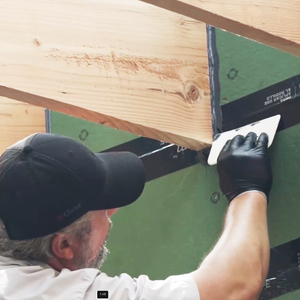I’m renovating my bathroom in N.J. The tub is situated against an exterior cinderblock and brick wall. There are vertical ferring strips nailed to the block. My plan was to insert ¾â€ thick white polystyrene insulation between the ferring strips, then tact 6 mil poly vapor barrier, then cement board, then ceramic tile. A contractor who priced the job told me that the new consensus of opinion is to eliminate the vapor barrier because it “traps†moisture. Does anyone here agree with this guy? Thanks in advance for any comments.
Discussion Forum
Discussion Forum
Up Next
Video Shorts
Featured Story

Ford Motor Company slashes prices for some F-150 Lightning models to stimulate demand for electric vehicles (EVs).
Highlights
"I have learned so much thanks to the searchable articles on the FHB website. I can confidently say that I expect to be a life-long subscriber." - M.K.

















Replies
Bump.
You describe a sticky situation if I understand the OP correctly.
From inside out - tile - cement board - furring w/insulation - block - brick.
Tile + grout + cement board is not water-vapor proof - this is behind the tub correct?
Brick + block is also not water-vapor proof.
The question becomes where within the wall section is the dewpoint?
If it were me - I would put in the 6mil poly. My rationale is that the greatest source of water, liquid or vapor, is from inside the bathroom.
This is based solely on the seat-of my-pants judgement, and may be completely wrong.
I'll watch and see what other, more informed folks say to this.
Jim
Never underestimate the value of a sharp pencil or good light.
Bump. Your post was about to fall off the list.
Jim
Never underestimate the value of a sharp pencil or good light.
Thanks Jim. I agree with your thoughts. I didn't think that anyone on this site would agree with this contractor advising to eliminate the vapor barrier.
If the block is unpainted, it will allow moisture to pass in either direction. The brick would probably do the same. Assuming there are no coatings that would hinder moisture movement, the question becomes: Where is the dew point going to be during critical seasons? Somewhere within the wall, there is a point where the inside temp and humidity and the outside temp and humidity interact. It is a kind of border.
In winter, the humidity will be higher in the home and will want to head out through the walls. When it encounters colder temperatures and even freezing temps, it will turn first to liquid, and then to ice. The points where the water and ice form will cause damage over time. How fast depends on the weather.
Conversely, in summer, the outside air will be warmer and contain more moisture. Therefore, the moisture will tend to enter the house through the walls. There will be no freezing problem; however, the point in the wall where the moisture (vapor) turns to liquid as it hits the dew point will be subject to damage from water.
This situation is more complex in a bathroom/shower/tub area, because the moisture will periodically exceed that on the outside of the home throughout the year.
In 1981, I built a block wall in Florida to enclose my carport and ultimately build a kitchen in its place. After I had the first few row of block in, a typical Florida rainstorm hit and the interior of the planned kitchen was filled with about four inches of water in about 15minutes. The rain stopped and the water ran out of the block walls in less than a minute. Essentially, the block was not much of a barrier to the liquid, and is less so to vapor.
This is a complex issue and boils down to how much you trust your contractor. Spend a few minutes and a few bucks to check him out. He may just be right in your particular situation.
Finally, if you choose to install a vapor barrier, you have control of the movement of moisture. Just be sure that you don't make things worse by installing it at the wrong point.
This subject gets much more complicated, but, for practical purposes, I think I have covered the main considerations.
Edited 10/4/2007 6:58 pm ET by Sasquatch
Without addressing block walls (solid masonry construction) and your other particulars, I'll say that here in NC - probably 8 hrs from you - 5 to 8 years ago most people used plastic vapor barriers. Now we don't because of fears of trapping moisture in the wall system causing mold. That is here though. I understand though(through BT) that plastic vapor barriers are still used widely the further you go north.
I'd say you need advice from in your direct geography.
If you have the space, I'd use extruded polystyrene panels (pink or blue board) and not the white expanded polystyrene. Use at least one inch thick, preferably 2", butting them tightly and then sealing with tape. This will give you more R value in the wall, will eliminate the thermal connection caused by having the firring directly against the block wall, and the EPS board is a vapor retarder. Also, make sure the bath is adequately ventilated.
I agree with RedfordHenry. Something not mentioned though is that with the sealed foam barrier and no conductive path, it should cause that dew point to remain within the foam region most of the time. That is where it shouldn't be much of an issue for condensation or water damage.